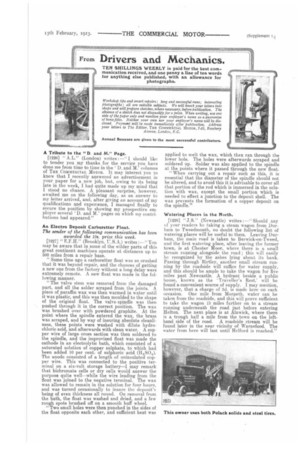Drivers and Mechanics.
Page 31

If you've noticed an error in this article please click here to report it so we can fix it.
TEN SHILLINGS WEEKLY is paid for the best communication received, and one penny a line of ten words for anything else published, with an allowance for photographs.
A Tribute to the "D. and M." Page.
[1226] " A .L." (London) writes :—" I should like to tender you my thanks for the service you have done me fnona time to time in the ' D. and M.' columns of THE COMMERCIAL MOTOR. It may interest you to know that I recently answered an advertisement in your paper for a new job, but, owing to its being late in the week, I had quite made up my mind that I stood no chance. A pleasant surprise, however, awaited me on the following day, as an answer to my letter arrived, and, after giving an account of my qualifications and experience, I managed finally to secure the position by showing my prospective employer several 'D. and M.' pages on which my contributions had appeared!'
An Eleetro Deposit Carburetter Float.
The sender of the following communication has been awarded the 10a. prize this week.
[1227] " E.F. H." (Brooklyn, r. S. A.) writes : —" You may be aware that in some of the wilder parts of this great continent machines operate at distances up to 500 miles from a repair base.
"Some time ago a carburetter float was so crushed that it was beyond repair, and the chances of getting a new one from the factory without a long delay were extremely remote. A new float was made in the following manner.
"The valve stem was removed from the damaged part, and all the solder scraped from the joints. A piece of paraffin wax was then warmed in water until it was plastic, and this was then moulded to the shape of the original float. The valve-spindle was then pushed through it in the correct position. The wax was brushed over with powdered graphite. At the point where the spindle entered the wax, the brass was scraped, and by way of insuring absolute cleanliness, these points were washed with dilute hydrochloric acid, and afterwards with clean water. A copper wire of large cross section was then soldered to the spindle, and the improvized float was made the cathode in an electrolytic bath, which consisted of a saturated solution of copper sulphate, to which had been added 10 per cent.. of sulphuric acid (H2SO4). The anode consisted of a length of uninsulated copper wire. This was connected to the positive terminal on a six-volt storage battery—I may remark that bichromate cells or dry cells would answer the purpose quite well—while the wire leading from the float was joined to the negative terminal. The wax was allowed to remain in the solution for four hours, and was turned occasionally to insure the deposit's being of even thickness all round. On removal from the bath, the float was washed and dried, and a few rough spots brushed off on a smooth buff wheel.
"Two small holes were then punched in the sides of the float opposite each other, and sufficient heat was
applied to melt the wax, which then ran through the lower hole. The holes were afterwards scraped and soldered up. Solder was also applied to the spindle at the points where it passed through the new float.
"When carrying out a repair such as this, it is essential that the diameter of the spindle should not be altered, and to avoid this it is advisable to cover all that portion of the rod which is immersed in the solution with wax, except the small portion which is needed to effect a junction to the deposit shell. The wax prevents the formation of a copper deposit on the spindle."
Watering Places in the North.
[12281 " J.S." (Newcastle) writes :—" Should any of your readers be taking a steam wagon from Durham to Tweedrnouth, no doubt the following list of watering places will be useful to them. Leaving Durham, the main road is taken to Berwick-on-Tweed, and the first watering place, after leaving the former town, is at Chester Moor, where there is a small stream running alongside the road ; this will easily be recognized by the ashes lying about its bank. Passing through Birtley, another small stream running by the roadside will suffice for water supply, and this should be ample to take the wagon for five miles past Newcastle. A hydrant beside a public house, known as the ' Traveller's Rest: will be found a convenient source of supply. I may mention, however, that a charge of 3d. is made here on each occasion. One mile from Alorpeth, water can be taken from the roadside, and this will prove sufficient to take the wagon 13 miles further on to a stream running underneath the road just before entering Helton. The next place is at Alnwick, where there is a trough half a mile from the town on the lefthand side of the road. A roadside stream will be found later in the near vicinity of Warneford. The water from here will last until Helforci is reached."
































